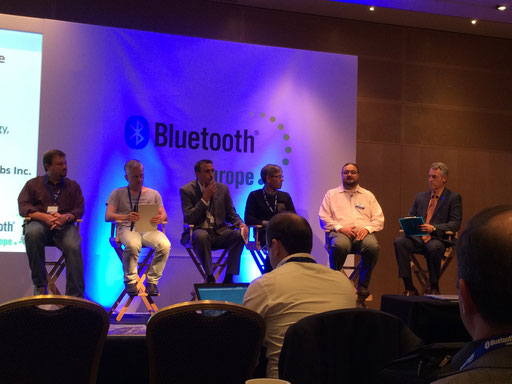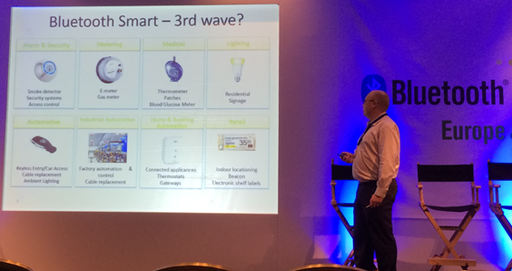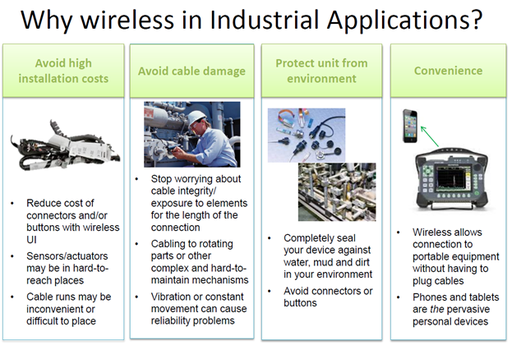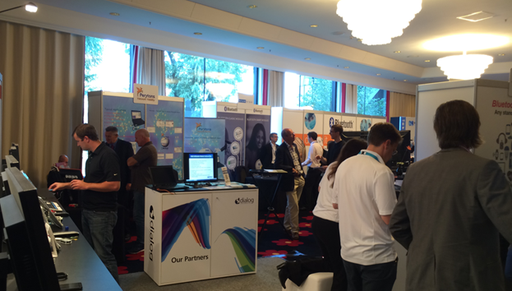Hello everyone
This is my first blog post on our Limmat site, where I will blog mostly on Bluetooth Low Energy, the Web of Things, and how to bring them together. Occasionally I will look at other protocols that may be relevant to the Internet of Things, and at Internet of Things architecture issues.

I'll start with a quick report on last week's Bluetooth Europe, the first and hopefully not the last European Bluetooth event. It has taken place on September 16 and 17 in Amsterdam. It was fully focused on Bluetooth Low Energy, although everyone went to great lengths to avoid this name, in favor of the Bluetooth Smart label. Google trend tells me that Bluetooth Smart is winning out, but I guess like most other techies, I feel that I can continue using the old name for a while, and in particular the BLE abbreviation. BS as abbreviation for Bluetooth Smart? No way!
Over the last two years, BLE has become highly popular in particular in the Wearables space: fitness trackers, smart watches, etc. Its growth has surpassed that of classic Bluetooth with audio streaming as its key use case, although last year's growth of BT classic of about 20% is nothing to sneeze at either. A market analyst expects that already in 2015, more BT chips that support BLE (single mode or dual mode) will be sold than pure classic BT chips.
The decisive success factor for BLE is the fact that all modern smartphones and tablets support it, so that there is no need for a gateway or router, unlike with most other radio technologies. As smartphones and tablets are also on the rise in the industrial sector, BLE has become attractive e.g. for commissioning and for the maintenance of devices, as fragile connectors and expensive displays can be dispensed with. Simplicity of use is another key success factor that has been mentioned repeatedly.
The conference gave a feeling for how BLE is getting established, in which market segments and at what speeds. The market for fitness devices looks poised to expand gradually to health devices (e.g., pulse meters) all the way to medical devices.
At the same time, BLE beacons are becoming more relevant, of course triggered by Apple's iBeacon standard which is based on BLE. Viewed from a technical perspective, beacons are the simplest possible application of BLE - a beacon essentially just broadcasts an ID. However, the use cases for such a "physical hyperlink" are surprisingly multifaceted: from indoor positioning - where GPS signals are not received anymore - to mobile marketing and logistics applications, e.g. the tracking of assets or also of people in the health care sector. As one speaker put it: beacons are like teenage sex: everyone talks about it, few do it. But we're definitely getting there.
Surprisingly, indoor positioning didn't play a large role at the conference. There was more interest in mobile marketing: an app running in the background on a smartphone can react depending on the proximity to beacons. For example, it may notify the user of a special deal offered by the shop in front of which the user currently is. How to realize such a scenario, while taking privacy concerns seriously, was presented as a case study involving Regent Street in London - the equivalent of Bahnhofstrasse in Zürich. The key for acceptance of the system was to give users full control over their data, and to only notify the user about very highly relevant offers. The appearance of being spammed by beacons was avoided at all costs.

Further emerging markets for BLE, which should become important in the coming two to three years, are home automation and industrial applications. Other areas may emerge as well; Leica Geosystems for example has presented an application in the construction industry: BLE smart laser distance meters.

Especially for home automation and industrial applications, cloud connectivity was a key topic, i.e., BLE as an "edge" technology for the Internet of Things. Integration of BLE with the cloud may happen at two layers: at the application layer (Web, i.e. HTTP) or at the transport layer (Internet, i.e. IP protocols). The Bluetooth SIG has published a standard for the first approach half a year ago (see here and here), the GATT REST API and the GAP REST API. This was particularly interesting for me, as we have been implementing this standard for our LImmat gateway. In the longer term, integration at the transport layer will also become relevant, e.g. by supporting a variant of 6LoWPAN on BLE. There is a Bluetooth SIG working group addressing this approach. One chip vendor has already announced to release their implementation still this year.
Battery life and range have also been perennial topics. There were presentations about highly power-frugal BLE chips, but also a talk by Prof. Meli of ZHAW about energy harvesting. He compared the different common methods for harvesting energy out of a device's environment. And one company presented a BLE module that achieves up to 450 m range, by using special amplification of the received signals.
Several speakers emphasized the importance of end-to-end security. In particular from an industrial perspective, the question is how to achieve this. Except for Apple's HomeKit Accessory Protocol I haven't seen a comprehensive approach so far.
Most attendees and speakers seemed to implicitly assume that permanent communication with the cloud is desirable or necessary. Only Robin Heydon, the author of the standard book on BLE, openly opposed this view. He didn't think it a good idea if a chair needs to communicate via the cloud e.g. with a climate control system, if it only wants to transmit one bit of information: "someone is sitting on me now". Instead, this should happen directly and thus without dependency on a live Internet connection. This led to a brief architecture discussion: distributed vs. central intelligence; vendor-independent standards versus "walled gardens" like the Apple ecosystem; dependencies on the cloud vs. the additional value gained; etc. It was necessarily a superficial discussion, though. Unfortunately, few seem to take the time to delve deeper into the intricate architecture issues, e.g. as raised by Clemens Vasters in his blog some time ago. I assume that very different approaches will be tested. As always, the market will decide which ones will prevail. In particular, how much security will really be demanded by the market.

This first Bluetooth Europe conference has certainly been a success. In spite of high prices it was booked out with about 300 attendees. I expect that it won't be the last such event in Europe.
Cuno Pfister, Oberon microsystems AG
 Limmat: Oberon microsystem's Blog
Limmat: Oberon microsystem's Blog